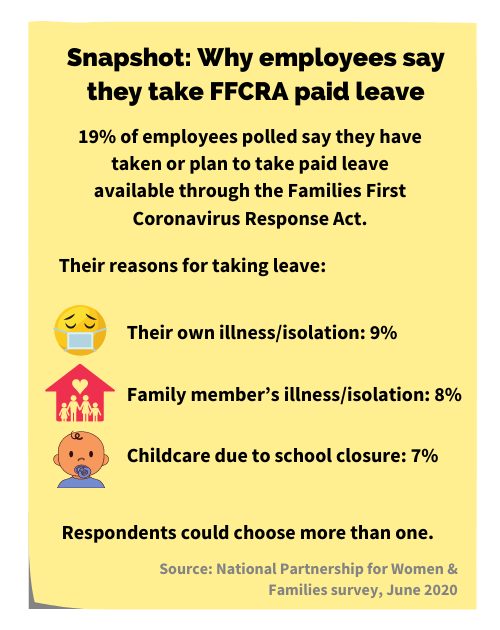Ask the Attorney: Paid leave and telework

These questions were submitted by participants of a recent FMLA training program and answered by speaker and employment lawyer, Anniken Davenport.
Q: “If an employee wants to take the emergency FMLA and we state they can work from home but the employee refuses because they can’t work at all due to watching their child, do they qualify for this leave? As a company, do we decide if we can provide telework or not?”
A: Employees generally cannot refuse to take telework when the absence is for school closures if their employer offers them the opportunity to do that telework around the child’s schedule. Offering alternative hours (i.e. early morning and late night) would be one way to show the employee could perform telework and thus not be eligible for the paid leave.
Here is how the DOL phrased its answer to a similar situation. “Similarly, if you are unable to perform those teleworking tasks or work the required teleworking hours because you need to care for your child whose school or place of care is closed, or child care provider is unavailable, because of COVID-19 related reasons, then you are entitled to take expanded family and medical leave. Of course, to the extent you are able to telework while caring for your child, paid sick leave and expanded family and medical leave is not available.”
Q: “What if we allowed telework previously due to our physical site not being open but now it is open … do we have to allow the telework?”
A: You do not have to offer telework generally. You may get requests for continued telework for a number of reasons that would trigger a possible ADA claim. For example, an employee may request continued telework as a reasonable accommodation because he has an underlying condition that puts him at greater risk for serious COVID complications or death. If the condition is an ADA disability, you should engage in the interactive accommodations process to determine if telework is a reasonable accommodation.

You should also check the latest information from the CDC regarding what conditions place employees at higher risk (for example, obesity, as measured by a BMI of 30 or more at any age, was recently added to the list of factors that indicate a worker may be a “vulnerable employee.” Whether BMI alone when related to COVID-19 risk is a covered ADA disability is uncertain at this point. It’s certainly likely that a worker with a BMI of 30 who is turned down for continued telework may sue. The employer would then have to show that BMI of 30 isn’t a covered disability or that it offered another kind of reasonable accommodation such as a safe workplace (ie. Proper social distancing, mask-wearing, disinfection, employee and customer screening, etc.)
You may find the EEOC’s past and current guidance on telework as a reasonable accommodation helpful when determining who should be allowed to keep working from home. Here and here is that guidance.
Q: “Can we offer an employee the option to telework if they have been diagnosed with positive COVID?”
A: Those who test positive for COVID may exhibit a range of illness from completely asymptomatic to desperately ill reliant on a respirator. Obviously, employers could not force a very ill employee to work by any means, including to telework. Presumably, if the employee is able to work because he or she is not hospitalized or ill at home, he or she theoretically could telework. If offered the option, the employee might request leave and the question would be if being offered the telework position would mean he or she would not be eligible for paid leave under the FFCRA. The answer is unclear.
Here is what the DOL says about offering telework in a Q&A:
“Generally, employees are allowed to telework under the FFCRA. However, telework is work for which normal wages must be paid and is not compensated under either of the paid leave provisions of the FFCRA….An employee is eligible for paid sick leave or expanded family and medical leave if the employer has work for the employee and he or she is unable to work (or telework) as a result of any of the COVID-19–qualifying reasons under the EFMLEA or the EPSLA. However, “if [the employee] and … employer agree that [the employee] will work [the employee’s] normal number of hours, but outside of [the employee’s] normally scheduled hours (for instance early in the morning or late at night), then [the employee is] able to work and leave is not necessary unless a COVID-19 qualifying reason prevents [the employee] from working that schedule.”
Does this mean that if the employee is well enough to work, he can be forced to telework rather than receive paid leave? The answer is a bit unclear.
Q: “We’re an essential employer in California and have many requests due to school and daycare closures. If an employee has exhausted FMLA and stated they still do not have childcare or the child is not returning to school onsite and are unable to work from home even in a part-time capacity, can we replace the employee? Or furlough the employee?”
A: Check with your counsel about any California-specific limitations, especially under California’s paid leave laws at both the state and local level. Many California municipalities have added Covid-19 related leave ordinances that go beyond federal law.
Assuming your employees have already used up their full 12 weeks of paid emergency FMLA leave for school/camp/daycare closures and any other accumulated leave they may have (personal, vacation, etc.) they would be subject to your usual absenteeism policies for missing work. Employers should be careful to treat employees who take FFCRA leave on the same terms as any other employee who takes any other form of leave. Automatically terminating employees who took FFCRA leave but not other leave takers may open the way for a retaliation lawsuit.






